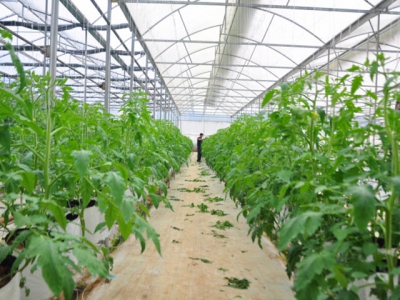Vegetable, flower growers excited back to their fields in Lam Dong

Vegetable and flower growers are excited to be back to their fields while the circulation of goods returns as normal in the Central Highlands Lam Dong Province.
Co-operatives and businesses promote the production of high-end farm produces to serve the Lunar New Year (Tet) market. Photo: Minh Hau.
Nguyen Van Tuan, a vegetable grower of Xuan Tho Commune in the province’s Da Lat City said his family has a 1.5 ha garden to plant vegetables and potatoes.
The farm produce of his garden are mainly consumed by traders in HCM City, he said.
When HCM City applied social distancing due to the COVID-19 pandemic, all wholesale markets in HCM City were temporarily shut down, so, he failed to seek the output to consume his farm produce, he said.
He suffers losses during the time, he said.
Currently, when the market is gradually stabilising, Tuan continues re-investing into his garden, he said.
He hires workers to plow the garden to plant cabbage, cauliflower, carrots, potatoes and gladiolus, he said.
Tuan said he has to borrow dozens of millions of dong to buy fertiliser and seedlings because fertiliser and seedlings agents required him to pay in advance instead of pay after he sold their farm produce.
“I hope I could earn some profit during the last months of this year, especially Tet,” he said.
According to the province’s Cultivation and Plant Protection Division, the province already supported seedlings and seeds for co-operatives, poor farmers and ethnic-minority households, who wanted to shift from growing flowers to short-term vegetables during the pandemic.
The provincial Agriculture and Rural Development Department will continue ordering localities to update the pandemic and weather developments to instruct local farmers to sow the seeds, the division said.
Besides, it also plans to develop production linkage chains to promptly serve the market on the occasion of 2022 Lunar New Year.
The province encourages local growers to use new varieties with high yield, focusing on growing plants that other regions and localities produce inefficiently to develop the market.
Ha Ngoc Chien, head of the division said local farmers are eager to cultivate while the current price of farm produces return to normal.
Many growers now have prepared to sow flower seeds to serve the market in the Lunar New Year in 2022.
In the meantime, growers of vegetables and fruits also focus on seasonal production.
This year's winter-spring crop of the province will cultivate on over 40,247 hectares, including about 24,696 hectares of vegetables with the estimated yield for vegetables of 856,152 tonnes; and 3,724 ha of flower with the estimated flower yield of about 1.4 million of branches.
According to Lam Dong Agriculture and Rural Development Department, provinces and cities in the country are not applied social distancing, therefore, restaurants and hotels have started to be operated. It results in the price of vegetables and flowers increasing.
Accordingly, it costs VND8,000 (USD 0.3) per kilo of climbing beans; VND18,000 per kilo of broccoli; VND17,000 per kilo of horn pepper; VND25,000 per kilo of lettuce, VND35,000 per kilo of spinach. All of the farm produces’ prices are much higher compared to the early October.
Every week, the province has about 1,500 hectares of vegetables for harvest with an estimated output of 36,000 tonnes, equal to about 5,100 tonnes of vegetables per day.
It now costs VND25,000 per 10 flowers of gerbera; VND50,000 per 10 flowers of auspicious while it costs VND55,000-70,000 per a bundle of Sorbonne and Concador lilies and VND30,000 per a bundle of roses. All the flowers’ prices are much higher compared to the early October.
Related news
 Mekong Delta farmers get higher profits when applying SRP standards
Mekong Delta farmers get higher profits when applying SRP standards Applying Sustainable Rice Platform (SRP) standards in rice production help reduce impacts on the environment, ensure livelihood and sustainable agriculture
 Imported sugar is almost two times higher than domestic sugar
Imported sugar is almost two times higher than domestic sugar Imported sugar rose sharply in the first nine months of 2021 with the import volume being almost two times higher than that of domestic production.
 Coffee as we know it is in danger. Can we breed a better cup?
Coffee as we know it is in danger. Can we breed a better cup? Farmers in the Bean Belt perilously depend on just two species. New breeding — and traditional growing practices — could fix that.